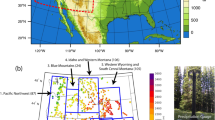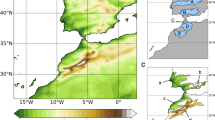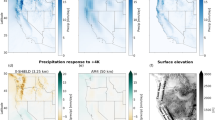Abstract
The Arctic has been warming faster than the global average during recent decades, and trends are projected to continue through the twenty-first century. Analysis of climate change impacts across the Arctic using dynamical models has almost exclusively been limited to outputs from global climate models or coarser regional climate models. Coarse resolution simulations limit the representation of physical processes, particularly in areas of complex topography and high land-surface heterogeneity. Here, current climate reference and future regional climate model simulations based on the RCP8.5 scenario over Alaska at 4 km grid spacing are compared to identify changes in snowfall and snowpack. In general, results show increases in total precipitation, large decreases in snowfall fractional contribution over 30% in some areas, decreases in snowpack season length by 50–100 days in lower elevations and along the southern Alaskan coastline, and decreases in snow water equivalent. However, increases in snowfall and snowpack of sometimes greater than 20% are evident for some colder northern areas and at the highest elevations in southern Alaska. The most significant changes in snow cover and snowfall fractional contributions occur during the spring and fall seasons. Finally, the spatial pattern of winter temperatures above freezing has small-scale spatial features tied to the topography. Such areas would not be resolved with coarser resolution regional or global climate model simulations.












Similar content being viewed by others
Data availability
The reference and future simulations are freely available at https://doi.org/10.5065/D61Z42T0. These include hourly 2-D surface output and six hourly 3-D atmosphere output.
References
Allen MR, Ingram WJ (2002) Constraints on future change in climate and the hydrologic cycle. Nature 419:228–232
Anderson EA (1973) National Weather Service river forecast system—snow accumulation and ablation model. NOAA Tech Memo NWS HYDRO-17, 217 pp.
Bieniek PA, Bhatt US, Walsh JE, Rupp TS, Zhang J, Krieger JR, Lader R (2016) Dynamical downscaling of ERA-interim temperature and precipitation for Alaska. J Appl Meteorol Climatol 55:635–654. https://doi.org/10.1175/JAMC-D-15-0153.1
Bieniek PA, Bhatt US, Walsh JE, Lader R, Griffith B, Roach JK, Thoman RL (2018) Assessment of Alaska rain-on-snow events using dynamical downscaling. J Appl Meteorol Climatol 57:1847–1863 https://doi-org.cuucar.idm.oclc.org/10.1175/JAMC-D-17-0276.1
Bintanja R, Andry O (2017) Towards a rain-dominated Arctic. Nat Clim Chang 7:263–267. https://doi.org/10.1038/nclimate3240
Budyko MI (1966) Polar ice and climate. In Proc. Syrup. on the Arctic Heat Budget and Atmospheric Circulation, J.O. Fletcher (Ed.), Rand Corp. Memorandum RM-5233-NSF, Santa Monica, California, 3-22
Clark M, Gangopadhyay S, Hay L, Rajagopalan B, Wilby R (2004) The Schaake shuffle: a method for reconstructing space–time variability in forecasted precipitation and temperature fields. J Hydrometeorol 5(1):243–262
Curry JA, Schramm JL, Ebert EE (1995) Sea ice-albedo climate feedback mechanism. J Clim 8(2):240–247
Dee D, Uppala S, Simmons A, Berrisford P, Poli P, Kobayashi S, Andrae U, Balmaseda M, Balsamo G, Bauer P et al (2011) The ERA-interim reanalysis: configuration and performance of the data assimilation system. Q J R Meteorol Soc 137(656):553–597. https://doi.org/10.1002/qj.828
Deser C, Phillips A, Bourdette V, Teng H (2012) Uncertainty in climate change projections: the role of internal variability. Clim Dyn 38:527–546. https://doi.org/10.1007/s00382-010-0977-x
Fyfe JC, Flato GM (1999) Enhanced climate change and its detection over the Rocky Mountains. J Clim 12(1):230–243. https://doi.org/10.1175/1520-0442-12.1.230
Hara M, Yoshikane T, Kawase H, Kimura F (2008) Estimation of the impact of global warming on snow depth in Japan by the pseudo-global-warming method. Hydrol Res Lett 2:61–64
Held I, Soden B (2006) Robust responses of the hydrological cycle to global warming. J Clim 19:5686–5699
Ikeda K, Rasmussen R, Liu C, Gochis D, Yates D, Chen F, Tewari M, Barlage M, Dudhia J, Miller K, Arsenault K, Grubisic V, Thompson G, Gutmann T (2010) Simulation of seasonal snowfall over Colorado. Atmos Res 97:462–477
Ikeda K, Rasmussen R, Liu C, Newman AJ, Chen F, Barlage M, Gutmann E, Dudia J, Dai A, Luce C, Musselman K (2020) Projected future changes in snowfall and snowpack in the Western U.S. as captured by a convection resolving climate simulation: mesoscale and microphysical factors. Clim Dyn, Under review
Jeong DI, Sushama L (2018) Rain-on-snow events over North America based on two Canadian regional climate models. Clim Dyn 50:303–316. https://doi.org/10.1007/s00382-017-3609-x
JPL MUR MEaSUREs Project. 2015. GHRSST Level 4 MUR Global Foundation Sea Surface Temperature Analysis (v4.1). Ver. 4.1. PO.DAAC, CA, USA. Dataset accessed [2016-10-30] at https://doi.org/10.5067/GHGMR-4FJ04
Kawase H, Yoshikane T, Hara M, Kimura F, Yasunari T, Ailikun B, Ueda H, Inoue T (2009) Intermodel variability of future changes in the Baiu rainband estimated by the pseudo global warming downscaling method. J Geophys Res Atmos 114(D24)
Kawase, H., M. Hara, T. Yoshikane, N. N. Ishizaki, F. Uno, H. Hatsushika, and F. Kimura, 2013: Altitude dependence of future snow cover changes over the Central Japan evaluated by a regional climate model. J Geophys Res, 118
Koenigk T, Berg P, Döscher R (2015) Arctic climate change in an ensemble of regional CORDEX simulations. Polar Res 34(1):24603. https://doi.org/10.3402/polar.v34.24603
Lader R, Walsh JE, Bhatt US, Bieniek PA (2017) Projections of twenty-first-century climate extremes for Alaska via dynamical downscaling and quantile mapping. J Appl Meteorol Climatol 56:2393–2409. https://doi.org/10.1175/JAMC-D-16-0415.1
Lader R, Walsh JE, Bhatt US, Bieniek PA (2020) Anticipated changes to the snow season in Alaska: elevation dependency, timing and extremes. Int J Climatol 40(1):169–187
Larsen, J.N., O.A. Anisimov, A. Constable, A.B. Hollowed, N. Maynard, P. Prestrud, T.D. Prowse, and J.M.R. Stone, 2014: Polar regions. In: Climate change 2014: impacts, adaptation, and vulnerability. Part B: Regional aspects. Contribution of Working Group II to the Fifth Assessment Report of the Intergovernmental Panel on Climate Change [Barros, V.R., C.B. Field, D.J. Dokken, M.D. Mastrandrea, K.J. Mach, T.E. Bilir, M. Chatterjee, K.L. Ebi, Y.O. Estrada, R.C. Genova, B. Girma, E.S. Kissel, A.N. Levy, S. MacCracken, P.R. Mastrandrea, and L.L. White (eds.)]. Cambridge University Press, Cambridge, United Kingdom and New York, NY, USA, pp. 1567–1612
Lewis SC, Karoly DJ (2013) Evaluation of historical diurnal temperature range trends in CMIP5 Models. J Clim 26:9077–9089. https://doi.org/10.1175/JCLI-D-13-00032.1
Li L, Gochis DJ, Sobolowski S, Mesquita MDS (2017) Evaluating the present annual water budget of a Himalayan headwater river basin using a high-resolution atmosphere-hydrology model. J Geophys Res Atmos 122:4786–4807. https://doi.org/10.1002/2016JD026279
Liu C, Ikeda K, Thompson G, Rasmussen R, Dudhia J (2011) High-resolution simulations of wintertime precipitation in the Colorado headwaters region: sensitivity to physics parameterizations. Mon Weather Rev 139:3533–3553. https://doi.org/10.1175/MWR-D-11-00009.1
Liu C, Ikeda K, Rasmussen R, Barlage M, Newman AJ, Prein AF, Chen F, Chen L, Clark M, Dai A, Dudhia J, Eidhammer T, Gochis D, Gutmann E, Kurkute S, Li Y, Thompson G, Yates D (2017) Continental-scale convection-permitting modeling of the current and future climate of North America. Clim Dyn. https://doi.org/10.1007/s00382-016-3327-9
Matte D, Laprise R, Thériault JM, Lucas-Picher P (2017) Spatial spin-up of fine scales in a regional climate model simulation driven by low-resolution boundary conditions. Clim Dyn 49(1–2):563–574
Maykut, G.A., 1986. The surface heat and mass balance. In The geophysics of sea ice (pp. 395-463). Springer, Boston, MA
McCrary, R.R. and L.O. Mearns, 2019: Quantifying and diagnosing sources of uncertainty in mid-century changes in North American snowpack from NARCCAP. J Hydrometeorol, 0, https://doi.org/10.1175/JHM-D-18-0248.1
McCrary RR, McGinnis S, Mearns LO (2017) Evaluation of snow water equivalent in NARCCAP simulations, including measures of observational uncertainty. J Hydrometeorol 18:2425–2452. https://doi.org/10.1175/JHM-D-16-0264.1
Mearns, L. O., W. J. Gutowski, R. Jones, L.-Y. Leung, S. McGinnis, A. M. B. Nunes, and Y. 810 Qian: A regional climate change assessment program for North America. EOS, Vol. 90, 811 No. 36, 8 September 2009, pp. 311–312
Minder JR, Letcher TW, Skiles SM (2016) An evaluation of high-resolution regional climate model simulations of snow cover and albedo over the Rocky Mountains, with implications for the simulated snow-albedo feedback. J Geophys Res Atmos 121:9069–9088. https://doi.org/10.1002/2016JD024995
Monaghan AJ, Clark MP, Barlage MP, Newman AJ, Xue L, Arnold JR, Rasmussen RM (2018) High-resolution historical climate simulations over Alaska. J Appl Meteorol Climatol 57(3):709–731
Musselman, K., Clark, M., Liu, C., K. Ikeda, and R. Rasmussen (2017). Slower snowmelt in a warmer world. Nat Clim Chang 7, 214–219 (2017) doi:https://doi.org/10.1038/nclimate3225
Musselman KN, Lehner F, Ikeda K, Clark M, Prein A, Liu C, Barlage M, Rasmussen R (2018) Projected increases and shifts in rain-on-snow flood risk over western North America. Nat Clim Chang 8:808–812
Pedersen SH, Liston GE, Tamstorf MP et al (2015) Quantifying episodic snowmelt events in Arctic ecosystems. Ecosystems 18:839. https://doi.org/10.1007/s10021-015-9867-8
Poujol B, Prein AF, Newman AJ, (2020) Kilometer-scale modeling projects a tripling of Alaskan convective storms in future climate. Climate Dynamics 55 (11–12):3543–3564
Prein AF, Holland GJ, Rasmussen RM, Done J, Ikeda K, Clark MP, Liu CH (2013) Importance of regional climate model grid spacing for the simulation of heavy precipitation in the Colorado headwaters. J Clim 26(13):4848–4857
Prein AF et al (2015) A review on regional convection-permitting climate modeling: demonstrations, prospects, and challenges. Rev Geophys 53(2):323–361
Rasmussen RM et al (2011) High resolution coupled climate-runoff simulations of seasonal snowfall over Colorado: a process study of current and warmer climate. J Clim 24:3015–3048. https://doi.org/10.1175/2010JCLI3985.1
Rasmussen R, Ikeda K, Liu C, Gochis D, Clark M, Dai A, Gutmann E, Dudhia J, Chen F, Barlage M, Yates D, Zhang G (2014) Climate change impacts on the water balance of the Colorado headwaters: high-resolution regional climate model simulations. J Hydrometeorol 15:1091–1116
Saito K, Walsh JE, Bring A, Brown R, Shiklomanov A, Yang D (2021) Future trajectory of Arctic system evolution. In: Yang D, Kane D (eds) Arctic hydrology, permafrost and ecosystems. Springer, Cham. https://doi.org/10.1007/978-3-030-50930-9_30
Schär C, Frei C, Lüthi D, Davies HC (1996) Surrogate climate-change scenarios for regional climate models. Geophys Res Lett 23(6):669–672
Screen, J.A. and Simmonds, I., 2010. The central role of diminishing sea ice in recent Arctic temperature amplification. Nature, 464(7293), p.1334
Skamarock WC, Klemp JB (2008) A time-split nonhydrostatic atmospheric model for weather research and forecasting applications. J Comput Phys 227:3465–3485. https://doi.org/10.1016/j.jcp.2007.01.037
Stocker, T.F., D. Qin, G.-K. Plattner, L.V. Alexander, S.K. Allen, N.L. Bindoff, F.-M. Bréon, J.A. Church, U. Cubasch, S. Emori, P. Forster, P. Friedlingstein, N. Gillett, J.M. Gregory, D.L. Hartmann, E. Jansen, B. Kirtman, R. Knutti, K. Krishna Kumar, P. Lemke, J. Marotzke, V. Masson-Delmotte, G.A. Meehl, I.I. Mokhov, S. Piao, V. Ramaswamy, D. Randall, M. Rhein, M. Rojas, C. Sabine, D. Shindell, L.D. Talley, D.G. Vaughan and S.-P. Xie, 2013: Technical summary. In: Climate change 2013: the physical science basis. Contribution of Working Group I to the Fifth Assessment Report of the Intergovernmental Panel on Climate Change [Stocker, T.F., D. Qin, G.-K. Plattner, M. Tignor, S.K. Allen, J. Boschung, A. Nauels, Y. Xia, V. Bex and P.M. Midgley (eds.)]. Cambridge University Press, Cambridge, United Kingdom and New York, NY, USA
Stroeve JC, Serreze MC, Holland MM et al (2012) The Arctic’s rapidly shrinking sea ice cover: a research synthesis. Clim Chang 110:1005. https://doi.org/10.1007/s10584-011-0101-1
Vaughan, D.G., J.C. Comiso, I. Allison, J. Carrasco, G. Kaser, R. Kwok, P. Mote, T. Murray, F. Paul, J. Ren, E. Rignot, O. Solomina, K. Steffen and T. Zhang, 2013: Observations: cryosphere. In: Climate change 2013: the physical science basis. Contribution of Working Group I to the Fifth Assessment Report of the Intergovernmental Panel on Climate Change [Stocker, T.F., D. Qin, G.-K. Plattner, M. Tignor, S.K. Allen, J. Boschung, A. Nauels, Y. Xia, V. Bex and P.M. Midgley (eds.)]. Cambridge University Press, Cambridge, United Kingdom and New York, NY, USA
Wakazuki Y, Rasmussen R (2015) Incremental dynamical downscaling for probabilistic analysis based on multiple ESM projections. Geophys Res Lett 42(24):10847–10855
Wang Y, Geerts B, Liu C (2018) A 30-year convection-permitting regional climate simulation over the interior western United States. Part I: Validation. Int J Climatol 38:3684–3704 https://doi-org.cuucar.idm.oclc.org/10.1002/joc.5527
Warner TT, Peterson RA, Treadon RE (1997) A tutorial on lateral boundary conditions as a basic and potentially serious limitation to regional numerical weather prediction. Bull Am Meteorol Soc 78:2599–2618. https://doi.org/10.1175/1520-0477(1997)078<2599:ATOLBC>2.0.CO;2
Acknowledgments
We would like to acknowledge Flavio Lehner and Joe Hamman for their helpful discussions regarding the sea ice methodology. We would also like to thank the three anonymous reviewers for their constructive reviews which greatly improved the manuscript.
Funding
This study was funded by the US Army Corps of Engineers Climate Preparedness and Resilience program and supported by the National Center for Atmospheric Research, which is a major facility sponsored by the National Science Foundation under Cooperative Agreement No. 1852977, specifically the NCAR Water System program.
Author information
Authors and Affiliations
Contributions
MPC, JRA, and AJN were responsible for the initial project proposal. AJM, KI, AJN, EDG, and LX were responsible for the model configuration and data preparation. AJM and AJN performed the reference and PGW WRF simulations, respectively. AJN performed the initial analysis and drafted the manuscript. All authors contributed to iterative analysis and editing the manuscript.
Corresponding author
Ethics declarations
Conflict of interest
The authors declare that they have no conflicts of interest.
Code availability
The WRF model is freely available at https://github.com/wrf-model/WRF
Additional information
Publisher’s note
Springer Nature remains neutral with regard to jurisdictional claims in published maps and institutional affiliations.
Supplementary information
ESM 1
(DOCX 18.1 mb)
Rights and permissions
About this article
Cite this article
Newman, A.J., Monaghan, A.J., Clark, M.P. et al. Hydroclimatic changes in Alaska portrayed by a high-resolution regional climate simulation. Climatic Change 164, 17 (2021). https://doi.org/10.1007/s10584-021-02956-x
Received:
Accepted:
Published:
DOI: https://doi.org/10.1007/s10584-021-02956-x




